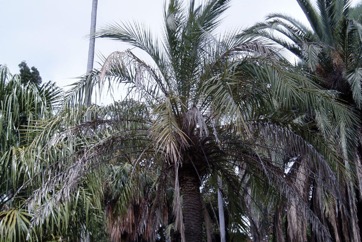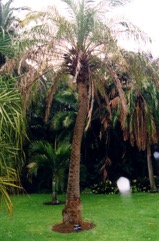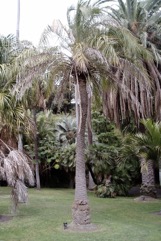India Date, Silver date palm

It grows in tropical and temperate regions. It can grow in inland and coastal districts. It needs a sunny position and a well drained soil. It grows on barren hills in India. It is often on sandy soils. It grows naturally in the Indus basin in Pakistan. It can grow up to 1500 m altitude in SE Asia. Melbourne Botanical gardens. In XTBG Yunnan.
Also known as:
Boa kadhuru, Boichand, Chhindi, Chotti khagoor, Date sugar palm, Deshi khejur, Desi khajoor, Eatha, Eetha pandlu, Etha, Ethum pannay, Ichalu, Icham, Inthaphalam-thai, Ita chettu, Jangali khajoor, Jangli khajur, Kajar, Kattueenthu, Kejur, Khajji, Khajoor, Khajur, Khajuri, Khakri, Kharak, Khejur palm, Khejur, Kojari, Oedda-ita, Palem korma perak, Pedda-ita, Pind, Sendi, Sendri, Shindi, Shindoli, Sindhi, Sindi, Silver Date palm, Sindi, Sugar date palm, Tadi, Taw-sunpalun, Thakal, Wild date palm
Synonyms
- Elate sylvestris L.
Edible Portion
- Fruit, Sap, Cabbage, Inner stem, Shoots, Palm heart
Where does India Date grow?
Found in: Asia, Australia, Bangladesh, China, Cuba, Fiji, Guam, Himalayas, India, Indochina, Indonesia, Maldives, Myanmar, Nepal, Northeastern India, NW India, Pacific, Pakistan, Rotuma, SE Asia, Sri Lanka, Thailand
Notes: There are 17 Phoenix species. It is indigenous to many parts of India.
Status: It is cultivated in large areas in India for sap. The fruit are sold in markets.
Growing India Date, Silver date palm
Cultivation: Plants are grown from seed. Seed germinate easily. Germination takes about 3 months.
Edible Uses: The sap from the stalk is used for a drink. It is also fermented. The ripe fruit are eaten raw. They can be used for jams or jellies. The seeds are edible. The flower stalk is tapped for sap which is boiled down to date sugar. It is used for jaggery and sugar. The growing tip or cabbage is eaten. A kind of sago can be extracted from the stem.
Production: It is quite fast growing. Sap can be taken from the side of the crown. This can be started when the palm is 7-10 years old and continue for 20-25 years. The annual yield per palm is 100 l of juice. This can be converted to 3 kg of sugar.
Nutrition Info
per 100g edible portion| Edible Part | Energy (kcal) | Protein (g) | Iron (mg) | Vitamin A (ug) | Vitamin c (mg) | Zinc (mg) | % Water |
|---|---|---|---|---|---|---|---|
| - | - | - | - | - | - |
India Date, Silver date palm Photos



References
Ambasta, S.P. (Ed.), 2000, The Useful Plants of India. CSIR India. p 449
Amoros, A., et al, 2014, Physico-chemical and functional characteristics of date fruits from different Phoenix species (Arecaceae). Fruits, Vol. 69, p. 315-323
Arora, R. K., 2014, Diversity in Underutilized Plant Species - An Asia-Pacific Perspective. Bioversity International. p 81
Bajpai, O., et al, 2015, Tree species of the Himalayan Terai region of Uttar Pradesh, India: a checklist. Check List 11(4): 1718
Balick, M.J. and Beck, H.T., (Ed.), 1990, Useful palms of the World. A Synoptic Bibliography. Colombia p 81, 200, 403, 435, 607,
Bandyopadhyay, S. et al, 2009, Wild edible plants of Koch Bihar district, West Bengal. Natural Products Radiance 8(1) 64-72
Bandyopadhyay, S., et al, 2012, A Census of Wild Edible Plants from Howrah District, West Bengal, India. Proceedings of UGC sponsored National Seminar 2012
Blomberry, A. & Rodd, T., 1982, Palms. An informative practical guide. Angus & Robertson. p 142
Bole, P.V., & Yaghani, Y., 1985, Field Guide to the Common Trees of India. OUP p 107
Burkill, I.H., 1966, A Dictionary of the Economic Products of the Malay Peninsula. Ministry of Agriculture and Cooperatives, Kuala Lumpur, Malaysia. Vol 2 (I-Z) p 1743
Chandrakumar, P., et al, 2015, Ethnobotanical studies of wild edible plants of Gond, Halba and Kawar tribes of Salekasa Taluka, Gondia District, Maharashtra State, India. International Research Journal of Pharmacy 6(8)
Chowdery, T., et al, 2014, Wild edible plants of Uttar Dinajpur District, West Bengal. Life Science Leaflets. 47:pp 20-36 http://lifesciencesleaflets.ning.com
Chowdhury, M. & Mukherjee, R., 2012, Wild Edible Plants Consumed by Local Communities of Maldah of West Bengal, India. Indian J.Sci.Res.3(2) : 163-170
Dangol, D. R. et al, 2017, Wild Edible Plants in Nepal. Proceedings of 2nd National Workshop on CUAOGR, 2017.
Das, S. and De, B., 2013, Evaluation of Angiotension I-Converting Enzyme (ACE) inhibitory potential of some underutilized indigenous fruits of West Bengal using an in vitro model. Fruits, Vol. 68:499-506
Dobriyal, M. J. R. & Dobriyal, R., 2014, Non Wood Forest Produce an Option for Ethnic Food and Nutritional Security in India. Int. J. of Usuf. Mngt. 15(1):17-37
Facciola, S., 1998, Cornucopia 2: a Source Book of Edible Plants. Kampong Publications, p 30
Fl. ind. ed. 1832, 3:787. 1832
Flora of Pakistan. www.eFloras.org
GAMMIE,
Gibbons, M., 2003, A pocket guide to Palms. Chartwell Books. p 162
Haynes, J., & McLaughlin, J., 2000, Edible palms and Their Uses. University of Florida Fact sheet MCDE-00-50-1 p 11
Hedrick, U.P., 1919, (Ed.), Sturtevant's edible plants of the world. p 489
Jabeen, A., et al, 2009, Indigenous uses of economically important flora of Margallah Hills National Park, Islamabad, Pakistan. African Journal of Biotechnology Vol. 8 (5), pp. 763-784
Jadhav, R., et al, 2015, Forest Foods of Northern Western Ghats: Mode of Consumption, Nutrition and Availability. Asian Agri-History Vol. 19, No. 4: 293-317
Johnson, D.V., 1998, Tropical palms. Non-wood Forest products 10. FAO Rome. p 42, 48, 123
Jones, D.L., 1994, Palms throughout the World. Smithtonian Institution, Washington. p 290
Jones, D.L., 2000, Palms of Australia 3rd edition. Reed/New Holland. p 197
Khan, D. & Shaukat, S.S., 2006, The Fruits of Pakistan: Diversity, Distribution, Trends of Production and Use. Int. J. Biol. Biotech., 3(3):463-499
Krishen P., 2006, Trees of Delhi, A Field Guide. DK Books. p 312
Kuhnlein, H. V., et al, 2009, Indigenous Peoples' food systems. FAO Rome p 195
Kumar, S. A., Manus, D. & Mallika, M., 2018, Impact of non-timber forest products on Forest and in Livelihood Economy of the People of Adjoining Areas of Jalpaiguri Forest Division, West Bengal, India. Int. J. of Life Sciences, 2018; 6 (2):365-385
Kunwar, R.M., et al, 2012, Underutilized Plant Species in Far West Nepal. J. Mt. Sci. (2012) 9:589-600
Kuvar, S. D. & Shinde, R. D., 2019, Wild Edible Plants used by Kokni Tribe of Nasik District, Maharashtra. Journal of Global Biosciences. Volume 8, Number 2, 2019, pp. 5936-5945
Majeed, M., et al, 2021, Gathered Wild Food Plants among Diverse Religious Groups in Jhelum District, Punjab, Pakistan. Foods 2021, 10, 594.
McClatchey, W., Thaman, R., & Vodonaivalu, S., 2000, A Preliminary Checklist of the Flora of Rotuma with Rotuman Names. Pacific Science (2000) Vol. 54, No. 4: 345-363
Misra S. & Misra M., 2016, Ethnobotanical and Nutritional Evaluation of Some Edible Fruit Plants of Southern Odisha, India. International Journal of Advances in Agricultural Science and Technology, Vol.3 Issue.1, March- 2016, pg. 1-30
Narayanan Ratheesh, M. K. et al, 2011, Wild edible plants used by the Kattunaikka, Paniya and Kuruma tribes of Wayanad District, Kerala, India. Journal of Medicinal Plants Research Vol. 5(15), pp. 3520-3529
Oudejans, J.H.M., 1979, Date palm, in Simmonds, N.W., (ed), Crop Plant Evolution. Longmans. London. p 230
Parmar, C., & Kaushel, M. K., 1982, In Wild Fruits. Kalyani Publishers, New Delhi, India. p 58-61
Pasha, M. K. & Uddin, S. B., 2019, Minor Edible Fruits of Bangladesh. Bangladesh J. Plant Taxon. 26(2): 299–313
Prachi, K., et al, 2012, Underutilized wild fruits of North Maharashtra. Journal of Research in Plant Sciences. (2012) 1:071-076
Pradhan, R., et al, 2020, Potential Wild Edible Plants and its Significance in Livelihood of Indigenous People of Male Mahadeshwara Hills, Karnataka. Economic Affairs Vol. 64, No. 4 pp. 01-14
PROSEA handbook Volume 9 Plants yielding non-seed carbohydrates. p 177
Purseglove, J.W., 1972, Tropical Crops. Monocotyledons. Longmans p 430
Ramachandran, V. S., 2007, Wild edible plants of the Anamalais, Coimbatore district, western Ghats, Tamil Nadu. Indian Journal or Traditional Knowledge. 6(1) pp 173-176
Rao, M. L. S., et al, 2014, Indigenous Plant Foods which are commonly consumed by the tribal communities in Dumbriguda Area of Visakhapatnam District, Andhra Pradesh, India. Biolife. Vol 2, Issue 3
Rashid, H. E., 1977, Geography of Bangladesh. Westview. p 294
Reddy, B. M., 2012, Wild edible plants of Chandrapur district, Maharashtra, India. Indian Journal of Natural Products and Resources. 3(1) pp 110-117
Reddy, K. N. et al, 2007, Traditional knowledge on wild food plants in Andhra Pradesh. Indian Journal of Traditional Knowledge. Vol. 6(1): 223-229
Reddy, K.R., 1989, Additional Notes on the Wild Edible Plants of India. J. Econ. Tax. Bot. Vol. 13 No. 1 pp 125-127
Riffle, R.L. & Craft, P., 2003, An Encyclopedia of Cultivated Palms. Timber Press. p 405
Setiya, A. V., et al, 2016, Exploration and documentation of some wild edible plants used by the aboriginals from Gadchiroli District (M.S.) India. International Advanced Research Journal in Science, Engineering and Technology. 3(7)
Shah, G.L., 1984, Some economically important plant of Salsette Island near Bombay. J. Econ. Tax. Bot. Vol. 5 No. 4 pp 753-765
Singh, H.B., Arora R.K.,1978, Wild edible Plants of India. Indian Council of Agricultural Research, New Delhi. p 68
Singh, V. and Singh, P., 1981, Edible Wild Plants of Eastern Rajasthan. J. Econ. Tax. Bot. Vol 2 pp 197-207
Sujanapal, P., & Sankaran, K. V., 2016, Common Plants of Maldives. FAO & Kerala FRI, p 202
Sukarya, D. G., (Ed.) 2013, 3,500 Plant Species of the Botanic Gardens of Indonesia. LIPI p 802
Swaminathan, M.S., and Kochnar, S.L., 2007, An Atlas of major Flowering Trees in India. Macmillan. p 276
Upreti, K., et al, 2010, Diversity and Distribution of Wild Edible Fruit Plants of Uttarakhand. Bioversity Potentials of the Himalaya. p 180
Uprety, Y., et al, 2016, Traditional use and management of NTFPs in Kangchenjunga Landscape: implications for conservation and livelihoods. Journal of Ethnobiology and Ethnomedicine (2016) 12:19
USDA, ARS, National Genetic Resources Program. Germplasm Resources Information Network - (GRIN). [Online Database] National Germplasm Resources Laboratory, Beltsville, Maryland. Available: www.ars-grin.gov/cgi-bin/npgs/html/econ.pl (10 April 2000)
WATT,
World Checklist of Useful Plant Species 2020. Royal Botanic Gardens, Kew